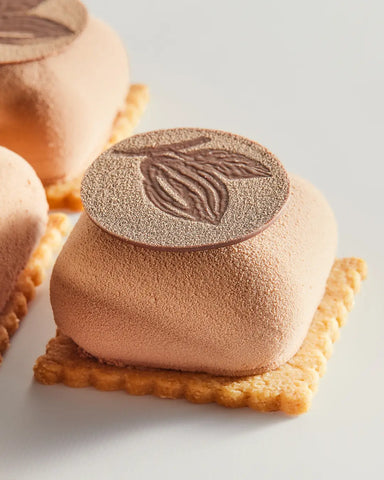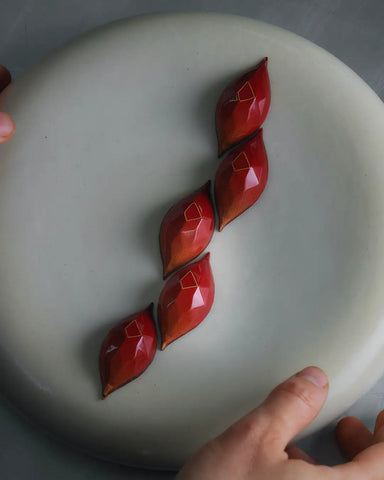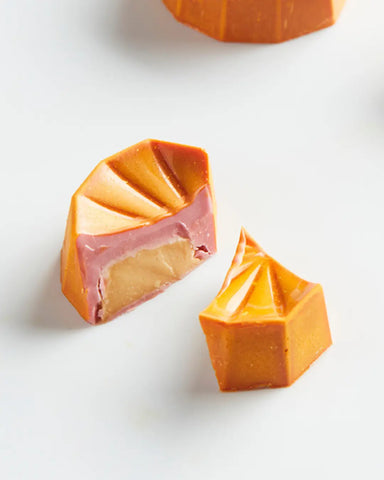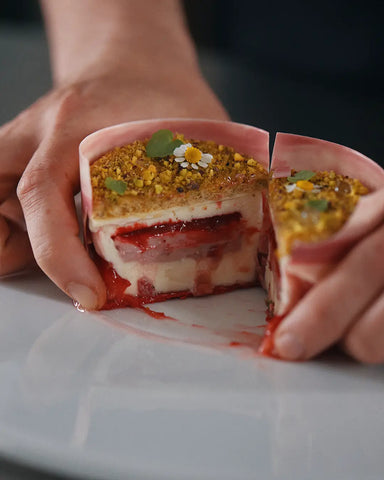
The Art and Science of Cacao Butter: Innovative Applications for Professional Pastry Chefs and Chocolatiers
Cacao butter, the creamy, aromatic fat extracted from cocoa beans, is a staple in the world of pastry and chocolate-making. While it has long been known for its role in giving chocolates their rich, smooth texture, today's top pastry chefs and chocolatiers are taking its application to new heights. From perfecting textures to creating visually stunning masterpieces, cacao butter is an essential ingredient that enables a range of creative possibilities in the kitchen. Here’s a deep dive into the innovative and advanced uses of cacao butter, offering inspiration for those who wish to elevate their craft.
1. Velvet Spray Effect: A Suede-Like Finish

In the world of fine desserts, presentation is just as important as flavor. One of the latest trends is the use of cacao butter in the velvet spray technique. This involves melting cacao butter with chocolate and spraying it onto frozen desserts, like entremets or ice cream bars, using a spray gun. The result is a beautiful, velvety finish that gives desserts a refined, matte texture.
Why it Works: When sprayed onto a frozen surface, the cacao butter and chocolate mixture solidifies instantly, creating a unique suede-like effect that contrasts perfectly with smooth glazes or shiny decorations.
Where to Use It: Try it on mousse cakes, frozen bonbons, or even layered desserts for a touch of luxury that catches the eye.
2. Colorful Cocoa Butter for Custom Chocolate Designs

For chocolatiers, colored cacao butter has become a game-changing tool. By mixing food-safe colors with cacao butter and airbrushing or painting it into molds, chefs can create intricate patterns and vibrant designs on bonbons and chocolate bars.
Why it Works: Cacao butter acts as a medium that holds the color while maintaining a smooth, glossy finish. It allows for detailed work that remains stable even after the chocolate has set.
Where to Use It: Ideal for holiday-themed chocolates, special occasion bonbons, or custom corporate designs, this technique transforms chocolate into an edible canvas.
3. Fat Bloom Control: Achieving the Perfect Snap
A common challenge in chocolate-making is fat bloom, where chocolate develops a dull, whitish layer due to unstable crystal formation. Cacao butter plays a crucial role in preventing this issue by helping to stabilize the chocolate during the tempering process.
Why it Works: By adding small amounts of cacao butter during tempering, chocolatiers can control the formation of stable cocoa butter crystals, ensuring a shiny, smooth appearance and a satisfying snap when the chocolate is broken.
Where to Use It: This technique is essential for any product where visual appeal is key, such as chocolate bars, pralines, and decorative chocolate pieces.
4. Infused Cocoa Butter: A Canvas for Flavor

Beyond its physical properties, cacao butter is an excellent medium for infusing flavors. By melting cacao butter and steeping it with herbs, spices, or even savory ingredients like truffles, chefs can create complex layers of flavor in their chocolate work.
Why it Works: Cacao butter's fat content absorbs and retains the volatile compounds from spices and herbs, adding depth to chocolates without introducing moisture that could disrupt the texture.
Where to Use It: This method is perfect for crafting luxury truffles, unique chocolate bars, or signature flavored ganaches that offer a sophisticated tasting experience.
5. Mycryo®: Simplifying the Tempering Process
Tempering chocolate is an art, but Mycryo®, a powdered form of cacao butter, has made it easier for professionals. Adding a precise amount of Mycryo® at specific temperatures helps achieve the ideal crystal structure without the need for extensive temperature monitoring.
Why it Works: Mycryo® introduces beta crystals into melted chocolate, ensuring a consistent structure that gives chocolate a perfect finish and prevents blooming.
Where to Use It: It's especially useful in high-volume kitchens or pastry labs where consistency and efficiency are critical, making it possible to produce perfectly tempered chocolates with less effort.
6. Vegan Butter Emulsions: A Dairy-Free Game Changer
With the rise of plant-based diets, cacao butter has become a key ingredient in creating vegan butter emulsions. By blending melted cacao butter with water or plant-based milks, chefs can create a rich, creamy texture that mimics traditional dairy-based creams.
Why it Works: Cacao butter’s high melting point and smooth mouthfeel make it an ideal substitute for dairy fats, providing a luxurious texture in vegan desserts.
Where to Use It: Use these emulsions to craft dairy-free ganaches, mousses, or creamy ice creams that will satisfy even the most discerning palates.
7. Micro-Texturing with Cacao Butter Sheets

For a touch of avant-garde flair, pastry chefs are now using cacao butter sheets to create micro-textures within layered desserts. These thin sheets, made by tempering cacao butter and spreading it into thin layers, can be used between layers of ganache or mousse to add a crisp texture.
Why it Works: These sheets add a delicate crunch that contrasts beautifully with softer elements in a dessert, making each bite more dynamic and interesting.
Where to Use It: Incorporate into plated desserts or as layers within pralines for a textural surprise that elevates the eating experience.
8. Cacao Butter Fat Transfers: Precision Flavor Delivery
Another advanced technique is using cacao butter as a medium for fat transfers, where concentrated flavors like citrus oils or spices are blended into cacao butter and used to infuse chocolate fillings or coatings.
Why it Works: The cacao butter allows for even distribution of these potent flavors without altering the consistency of the chocolate, ensuring a balanced flavor profile.
Where to Use It: This technique is perfect for creating high-end pralines with flavors that stand out without overwhelming the palate, such as spiced orange truffles or herbal-infused ganaches.
9. Next-Level Ice Creams with Cacao Butter

In modern ice cream production, cacao butter is used to create smooth, stable coatings that maintain structure even at low temperatures. It helps achieve a rich, creamy mouthfeel in chocolate ice creams by stabilizing fat content.
Why it Works: Cacao butter’s ability to solidify at room temperature allows it to form a thin, crisp shell around ice creams, enhancing both texture and flavor.
Where to Use It: It’s ideal for creating dipped ice cream bars or adding a creamy twist to chocolate sorbets, providing a gourmet edge to frozen treats.
Elevating Your Craft with Cacao Butter
From creating intricate designs on bonbons to mastering the art of tempering, cacao butter remains a cornerstone of the professional pastry and chocolate-making world. By exploring these advanced applications, chefs can push the boundaries of traditional desserts, offering customers a truly unique sensory experience. Whether you’re a chocolatier looking to refine your techniques or a pastry chef aiming to add a creative twist to your repertoire, mastering the versatile properties of cacao butter will open up a world of possibilities.
Let your imagination run wild, and let cacao butter be your guide to crafting desserts that delight the eyes, tantalize the taste buds, and leave a lasting impression.
